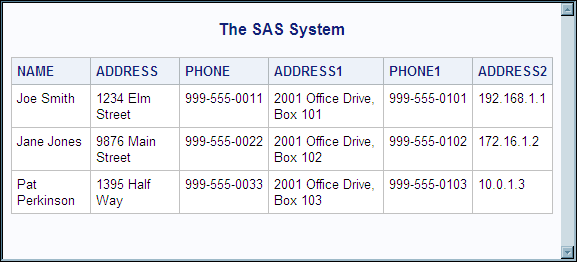Including Namespace Elements in an XMLMap
This example illustrates
the XMLMap namespace elements. The XMLMap namespace elements enable
you to import an XML document with like-named elements that are qualified
with XML namespaces. The XMLMap namespace elements maintain XML namespaces
from the imported XML document to export an XML document with namespaces
from the SAS data set.
Here is an XML document
named NSSample.xml to be imported. The XML document contains three
XML namespaces. The namespaces distinguish ADDRESS elements by qualifying
them with references to unique URIs. The ADDRESS elements are highlighted
below in the first PERSON repeating element:
<?xml version="1.0" encoding="UTF-8"?>
<PEOPLE xmlns:HOME="http://sample.url.org/home"
xmlns:IP="http://sample.url.org/ip"
xmlns:WORK="http://sample.url.org/work">
<PERSON>
<NAME>Joe Smith</NAME>
<HOME:ADDRESS>1234 Elm Street</HOME:ADDRESS>
<HOME:PHONE>999-555-0011</HOME:PHONE>
<WORK:ADDRESS>2001 Office Drive, Box 101</WORK:ADDRESS>
<WORK:PHONE>999-555-0101</WORK:PHONE>
<IP:ADDRESS>192.168.1.1</IP:ADDRESS>
</PERSON>
<PERSON>
<NAME>Jane Jones</NAME>
<HOME:ADDRESS>9876 Main Street</HOME:ADDRESS>
<HOME:PHONE>999-555-0022</HOME:PHONE>
<WORK:ADDRESS>2001 Office Drive, Box 102</WORK:ADDRESS>
<WORK:PHONE>999-555-0102</WORK:PHONE>
<IP:ADDRESS>172.16.1.2</IP:ADDRESS>
</PERSON>
<PERSON>
<NAME>Pat Perkinson</NAME>
<HOME:ADDRESS>1395 Half Way</HOME:ADDRESS>
<HOME:PHONE>999-555-0033</HOME:PHONE>
<WORK:ADDRESS>2001 Office Drive, Box 103</WORK:ADDRESS>
<WORK:PHONE>999-555-0103</WORK:PHONE>
<IP:ADDRESS>10.0.1.3</IP:ADDRESS>
</PERSON>
</PEOPLE>
Here is the XMLMap that
was used to import the XML document. Notations describe the namespace
elements.
<SXLEMAP name="Namespace" version="2.1">
<NAMESPACES count="3"> 1
<NS id="1" prefix="HOME">http://sample.url.org/home</NS> 2
<NS id="2" prefix="IP">http://sample.url.org/ip</NS>
<NS id="3" prefix="WORK">http://sample.url.org/work</NS>
</NAMESPACES>
<TABLE description="PERSON" name="PERSON"> 3
<TABLE-PATH syntax="XPath">/PEOPLE/PERSON</TABLE-PATH>
<COLUMN name="NAME"> 4
<PATH syntax="XPath">/PEOPLE/PERSON/NAME</PATH>
<TYPE>character</TYPE>
<DATATYPE>string</DATATYPE>
<LENGTH>13</LENGTH>
</COLUMN>
<COLUMN name="ADDRESS"> 4
<PATH syntax="XPathENR">/PEOPLE/PERSON/{1}ADDRESS</PATH> 5
<TYPE>character</TYPE>
<DATATYPE>string</DATATYPE>
<LENGTH>16</LENGTH>
</COLUMN>
<COLUMN name="PHONE"> 4
<PATH syntax="XPathENR">/PEOPLE/PERSON/{1}PHONE</PATH>
<TYPE>character</TYPE>
<DATATYPE>string</DATATYPE>
<LENGTH>12</LENGTH>
</COLUMN>
<COLUMN name="ADDRESS1"> 4
<PATH syntax="XPathENR">/PEOPLE/PERSON/{3}ADDRESS</PATH>
<TYPE>character</TYPE>
<DATATYPE>string</DATATYPE>
<LENGTH>26</LENGTH>
</COLUMN>
<COLUMN name="PHONE1"> 4
<PATH syntax="XPathENR">/PEOPLE/PERSON/{3}PHONE</PATH>
<TYPE>character</TYPE>
<DATATYPE>string</DATATYPE>
<LENGTH>12</LENGTH>
</COLUMN>
<COLUMN name="ADDRESS2"> 4
<PATH syntax="XPathENR">/PEOPLE/PERSON/{2}ADDRESS</PATH>
<TYPE>character</TYPE>
<DATATYPE>string</DATATYPE>
<LENGTH>11</LENGTH>
</COLUMN>
</TABLE>
</SXLEMAP>
-
In the PATH element for each COLUMN element, the type of syntax is specified as XPathENR (XPath with Embedded Namespace Reference). This type indicates that the syntax is not compliant with the XPath specification. In addition, the identification number is included in the location path preceding the element that is being defined. The identification number is enclosed in braces. For example, this is the PATH element for the ADDRESS element:
<PATH syntax="XPathENR">/PEOPLE/PERSON/{1}ADDRESS</PATH>.
The following SAS statements
import the XML document and specify an XMLMap named NSSample.map.
The PRINT procedure shows the resulting SAS data set:
